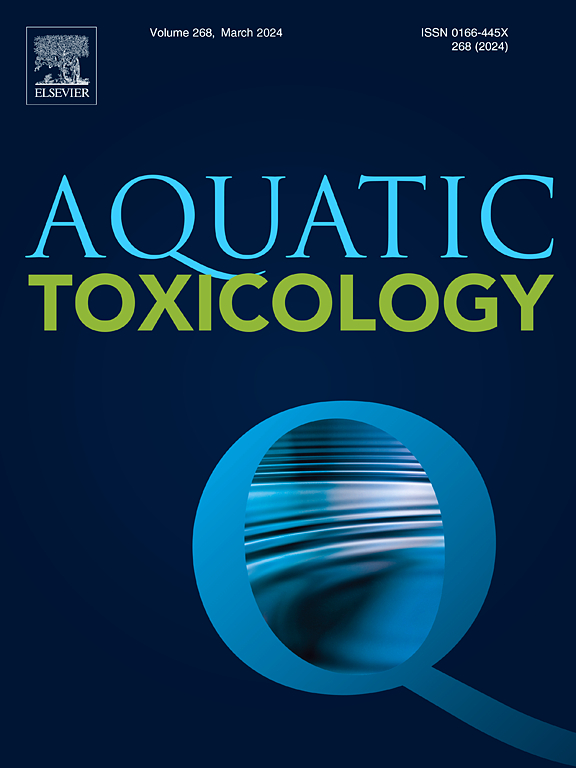A transcriptomics-based analysis of mechanisms involved in the neurobehavioral effects of 6PPD-quinone on early life stages of zebrafish
IF 4.1
2区 环境科学与生态学
Q1 MARINE & FRESHWATER BIOLOGY
引用次数: 0
Abstract
As an emerging pollutant frequently detected in aquatic ecosystems, the toxicity of N-(1,3-dimethylbutyl)-N’-phenyl-p-phenylenediamine-quinone (6PPD-quinone) on fish has been confirmed, but insight into the mechanisms underlying those adverse effects is still limited. Thus, we exposed zebrafish embryos to 6PPD-quinone at 0, 0.25, 2.5, and 25 μg/L until 120 h post-fertilization (hpf), and investigated the variations in their development, behavior, monoamine neurotransmitter levels, and transcriptional profile. Exposure to 6PPD-quinone notably elevated the heart rate of zebrafish at 48 hpf (at 2.5 and 25 μg/L) and 72 hpf (at 0.25, 2.5, and 25 μg/L). In the dark-light transition test, the locomotor activity of zebrafish larvae exposed to 6PPD-quinone significantly increased, especially in the dark periods. Exposure to 6PPD-quinone also altered the dopamine level and its turnover in zebrafish, which exhibited significant correlations to their locomotor activity. RNA sequencing identified 394 differentially expressed genes (DEGs), most of which have the molecular function of binding and catalytic activity. Five DEGs were predicted as the key driver genes in the protein-protein interaction networks associated with circadian rhythm (i.e., npas2), protein processing in endoplasmic reticulum (i.e., hsp90b1 and pdia4), and estrogen signaling pathway (i.e., hsp90aa1.1 and hsp90aa1.2). Our findings provide more insights into mechanisms underlying the toxicity of 6PPD-quinone to teleosts and highlight the necessity to assess its potential risks to aquatic ecosystems.
基于转录组学分析 6PPD-quinone 对斑马鱼早期神经行为影响的机制。
N-(1,3-二甲基丁基)-N'-苯基-对苯二胺-醌(6PPD-quinone)作为一种在水生生态系统中经常检测到的新出现的污染物,其对鱼类的毒性已被证实,但对这些不利影响的机制的了解仍然有限。因此,我们将斑马鱼胚胎暴露于 0、0.25、2.5 和 25 μg/L 的 6PPD-quinone 中,直至受精后 120 h(hpf),并研究了其发育、行为、单胺神经递质水平和转录谱的变化。暴露于6PPD-醌的斑马鱼在48 hpf(2.5和25 μg/L)和72 hpf(0.25、2.5和25 μg/L)时心率显著升高。在暗光转换试验中,暴露于 6PPD-quinone 的斑马鱼幼体的运动活动显著增加,尤其是在黑暗时期。暴露于 6PPD-quinone 还改变了斑马鱼体内的多巴胺水平及其周转,这与斑马鱼的运动活动有明显的相关性。RNA测序发现了394个差异表达基因(DEGs),其中大部分具有结合和催化活性的分子功能。有五个 DEGs 被预测为与昼夜节律(即 npas2)、内质网蛋白质加工(即 hsp90b1 和 pdia4)和雌激素信号通路(即 hsp90aa1.1 和 hsp90aa1.2)相关的蛋白质-蛋白质相互作用网络中的关键驱动基因。我们的研究结果进一步揭示了 6PPD-quinone 对远洋鱼类的毒性机制,并强调了评估其对水生生态系统潜在风险的必要性。
本文章由计算机程序翻译,如有差异,请以英文原文为准。
求助全文
约1分钟内获得全文
求助全文
来源期刊

Aquatic Toxicology
环境科学-毒理学
CiteScore
7.10
自引率
4.40%
发文量
250
审稿时长
56 days
期刊介绍:
Aquatic Toxicology publishes significant contributions that increase the understanding of the impact of harmful substances (including natural and synthetic chemicals) on aquatic organisms and ecosystems.
Aquatic Toxicology considers both laboratory and field studies with a focus on marine/ freshwater environments. We strive to attract high quality original scientific papers, critical reviews and expert opinion papers in the following areas: Effects of harmful substances on molecular, cellular, sub-organismal, organismal, population, community, and ecosystem level; Toxic Mechanisms; Genetic disturbances, transgenerational effects, behavioral and adaptive responses; Impacts of harmful substances on structure, function of and services provided by aquatic ecosystems; Mixture toxicity assessment; Statistical approaches to predict exposure to and hazards of contaminants
The journal also considers manuscripts in other areas, such as the development of innovative concepts, approaches, and methodologies, which promote the wider application of toxicological datasets to the protection of aquatic environments and inform ecological risk assessments and decision making by relevant authorities.
 求助内容:
求助内容: 应助结果提醒方式:
应助结果提醒方式:


